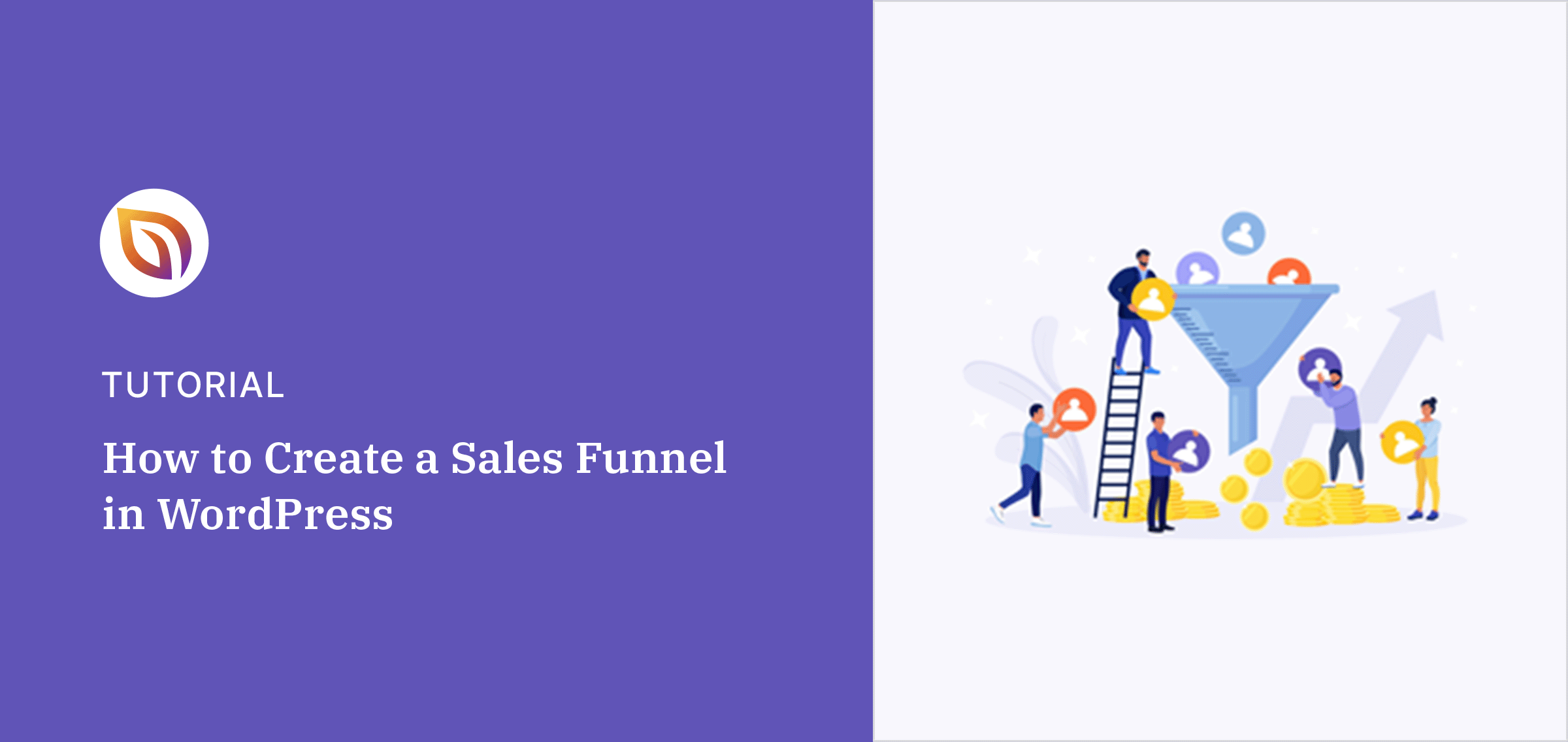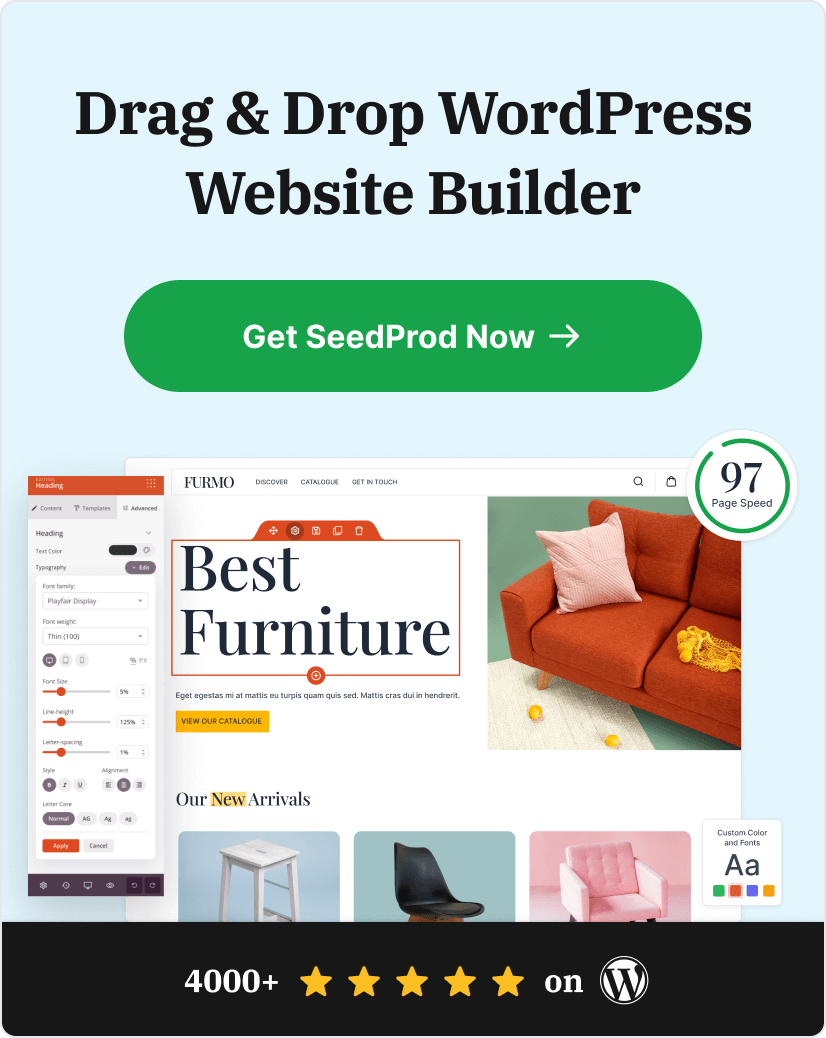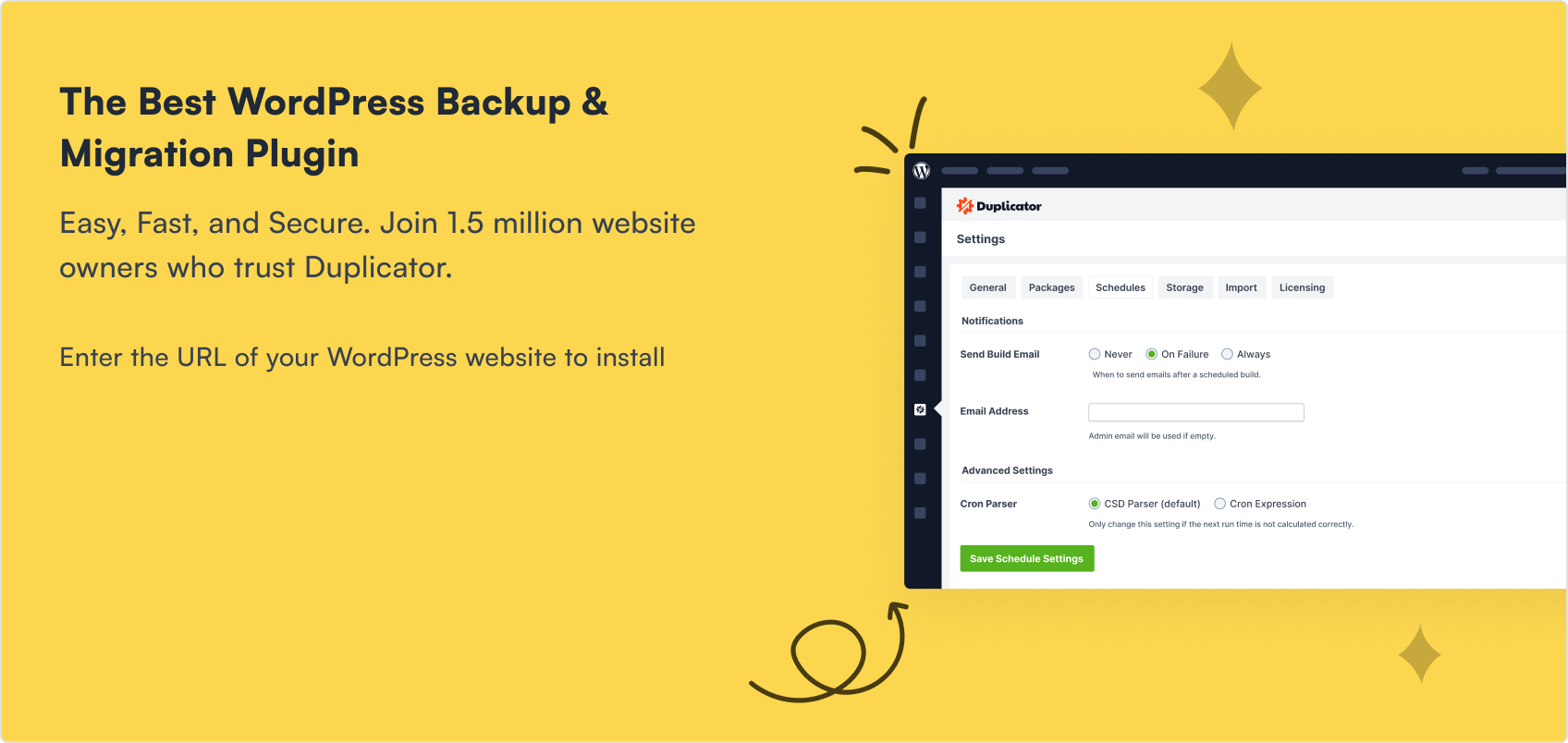A WordPress sales funnel is a step-by-step path that guides visitors from first click to purchase. You can build it with plugins to create landing pages, capture leads, send follow-ups, and convert visitors into paying customers.
I struggled with random traffic that didn’t convert until I built my first funnel. In this guide, I’ll walk you through how to make a sales funnel in WordPress the simple way, so you can start turning visitors into loyal customers too.
Quick Steps to Create a WordPress Sales Funnel:
- Create a Landing Page
- Add a Lead Generation Form
- Use Opt-in Popups
- Upsell WooCommerce Products
- Simplify Your Checkout
- Build a Thank You Page
- Track Funnel Results
What Is a Sales Funnel?
A sales funnel is the path a person takes from first discovering your business to becoming a paying customer.
Think of your sales funnel not as a single plugin, but as the connected path you create for your visitors using a few key tools working together.
Most marketers break this journey into stages that follow how people make buying decisions, from realizing they have a problem to actively looking for a solution.
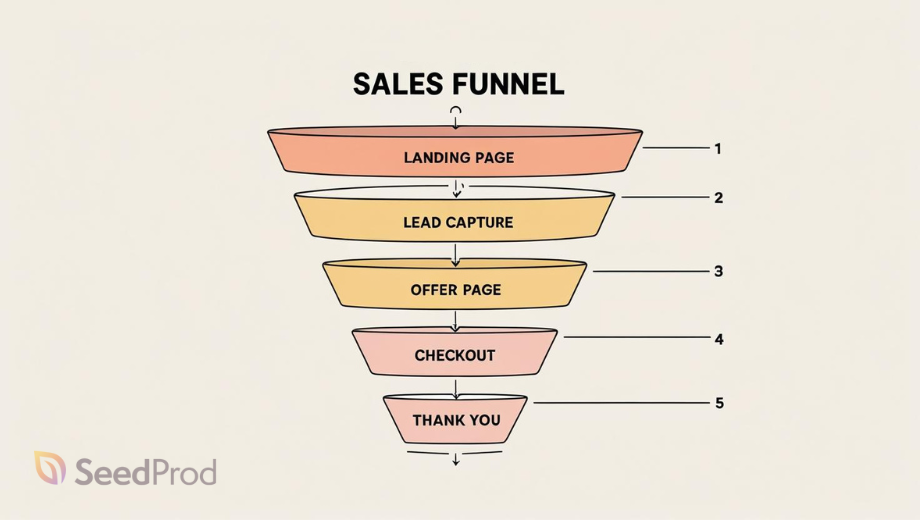
For WordPress websites, your sales funnel includes all the pages visitors see before buying something. This could be your blog posts, landing pages, product pages, and checkout process.
If you have a WordPress website where you sell products or services, you already have a sales funnel, even if you didn’t create it intentionally. Every page that leads to a purchase is part of your funnel.
Your funnel might have several steps. For example, someone might:
- Find your blog post through Google
- Click to read more about your service
- Sign up for your free guide
- Get your email follow-ups
- Finally decide to buy
The good news is you can improve each of these steps. You can make pages easier to use, remove things that distract visitors, and encourage more people to buy.
Best of all, you can track how well your funnel works. This lets you test different approaches and make smart choices based on real data about what your visitors do.
Now that you understand what a sales funnel is, let’s look at how to create one in WordPress.
Steps to Make a Sales Funnel in WordPress (Beginner Guide)
Heads up: Steps 4 and 5 focus on selling products with WooCommerce. If you’re using your funnel for leads or services, you can skip ahead to Step 6.
With the essentials in place, let’s look at the steps to create a sales funnel that turns casual visitors into committed buyers.
1. Create a Sales Funnel Landing Page in WordPress
Your landing page is the entrance to your funnel. It should grab attention, explain your offer, and push one clear action.
In fact, 68% of businesses use landing pages to generate leads, and they work best with a simple layout, strong headline, and zero distractions.
In my experience, SeedProd is the best way to build high-converting landing pages in WordPress. It comes with over 300 professionally designed templates, which have cut my setup time in half compared to building from scratch. This lets me focus more on the message than the design.
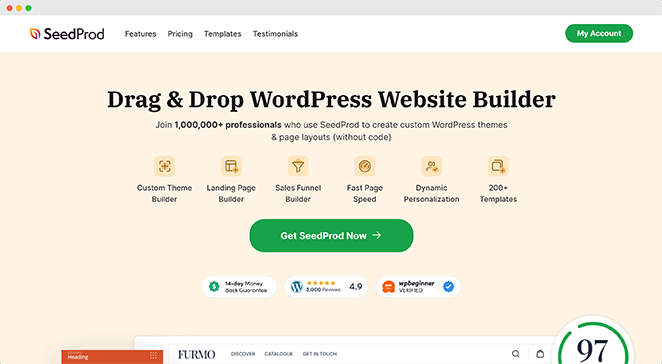
SeedProd’s drag-and-drop builder makes it simple to customize every part of the page, from the headline to the call-to-action, without touching code. You can add timers, opt-in forms, and testimonials in seconds.
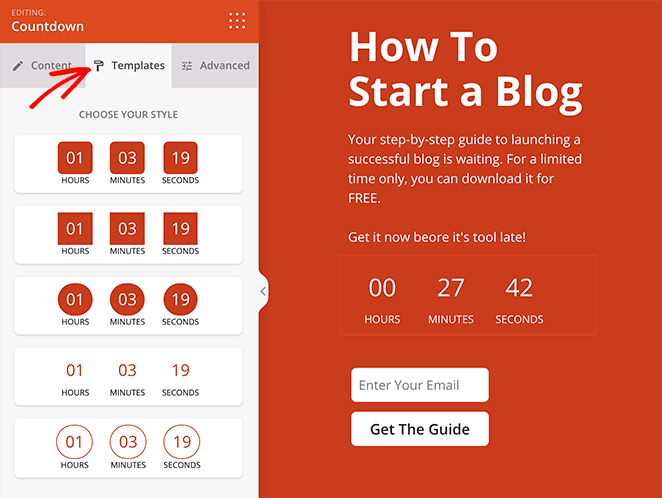
Every template is optimized for conversions, which means you start with a proven layout that’s already designed to get clicks and signups. That’s why it’s my go-to tool whenever I need a funnel that performs fast.
For help getting started, you can see our tutorial on how to create a sales funnel landing page in WordPress.
What should a sales funnel landing page include?
A good landing page has one clear goal. Use a strong headline, short benefit bullets, and a single call-to-action button. Add trust elements like reviews or logos. Remove distractions such as menus or sidebars.
What headline works best on a sales funnel landing page?
Call out the problem and the outcome in one line. For example: “Get More Sales From the Traffic You Already Have.” Keep it short and specific.
What should a sales funnel landing page include?
A good landing page has one clear goal. Use a strong headline, short benefit bullets, and a single call-to-action button. Add trust elements like reviews or logos. Remove distractions such as menus or sidebars.
What headline works best on a sales funnel landing page?
Call out the problem and the outcome in one line. For example: “Get More Sales From the Traffic You Already Have.” Keep it short and specific.
2. Build a Lead Generation Form in WordPress
Most people won’t buy the first time they visit your site, which is why a lead form is so important. It helps you stay in touch and keep building trust.
After testing several form builders, I always come back to WPForms. Trusted by over 6 million websites, its drag-and-drop builder lets me create and publish a working lead form in under five minutes — something I’ve done across dozens of client sites.

WPForms includes pre-made templates that make form setup almost effortless. You can connect it with your favorite email marketing services and embed your form anywhere on your site or landing page.

I also love that WPForms integrates directly with SeedProd. This means I can drop any form right into a landing page design without switching between tools. It’s a huge time-saver when building funnels that capture leads fast.
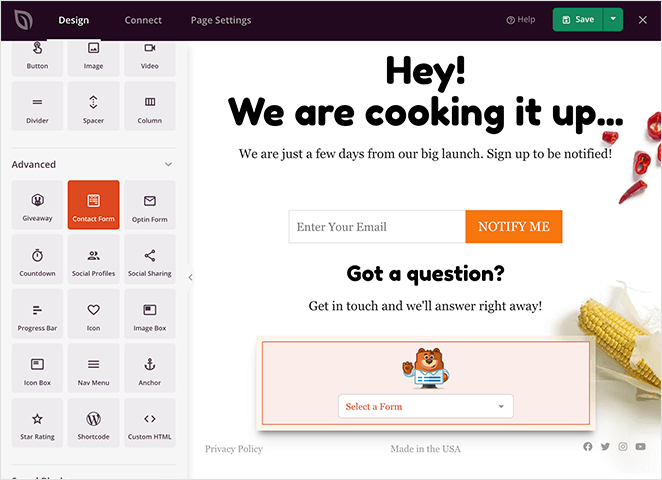
What fields should I use on a lead form?
Keep it short. Just ask for name and email. Fewer fields = higher conversions. You can qualify leads later by email.
What offer gets more signups?
Give away a quick win. A checklist, template, or discount code works well. Deliver it on your thank you page and by email.
For instructions, see our guide on how to create a landing page with a form.
3. Add Opt-in Popups to Boost Conversions
Popups give you a second chance to capture a visitor’s attention before they leave your site. When timed right, they can recover leads that would otherwise be lost.
I use OptinMonster here on our website, and it’s been one of the most effective ways to grow our email list. Specifically, its exit-intent trigger has consistently recovered about 5% of abandoning visitors by showing a final offer just before they close the page.
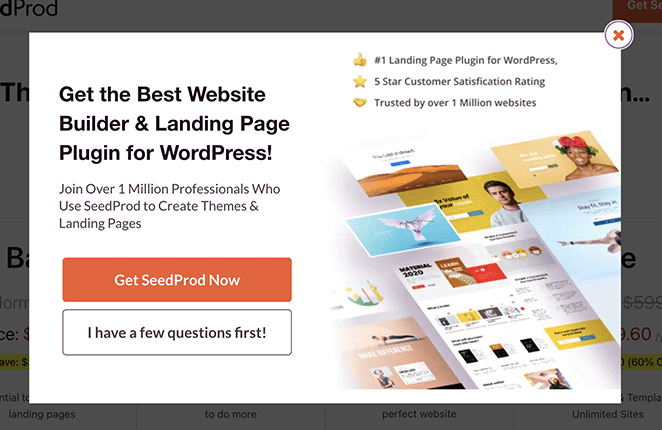
OptinMonster’s drag-and-drop builder and pre-made templates make it easy to design lightbox popups, floating bars, and slide-ins in minutes, without coding. I can launch and test campaigns quickly, which helps me learn what converts best for my audience.
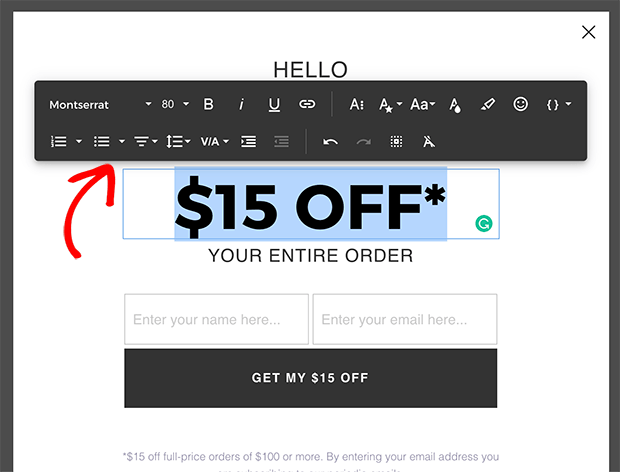
Its targeting rules are where it really shines. You can show the right offer at the right moment, like displaying free shipping to users in specific locations or discounts when a visitor scrolls past a certain point.
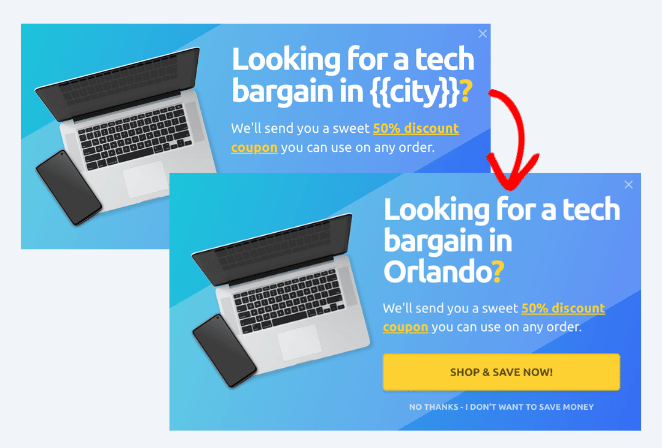
Popups are powerful because they turn “almost lost” visitors into subscribers or customers. I’ve seen them make a noticeable difference in funnel performance with only a few small tweaks.
Follow this guide to learn how to create an exit popup in WordPress.
Why use popups in a sales funnel?
Popups catch visitors before they leave. They give you a second chance to collect an email or promote an offer.
What makes a popup work best?
Show it at the right time. Use exit intent popups when someone is about to close the page. Add a clear benefit like a discount or free download.
4. Upsell Your WooCommerce Products
Upsells are one of the easiest ways to increase your average order value. By offering relevant add-ons or upgrades right before checkout, you can turn a single sale into a more profitable one.
I’ve used tools like FunnelKit for several eCommerce clients, and its one-click upsell feature alone increased average order value by over 15% in a recent project. That kind of result makes it a staple in my funnel-building toolkit.
FunnelKit lets you add pre- and post-purchase upsells directly in WooCommerce without breaking the checkout flow. Customers can add upgrades with one click, which keeps the buying process smooth and fast.
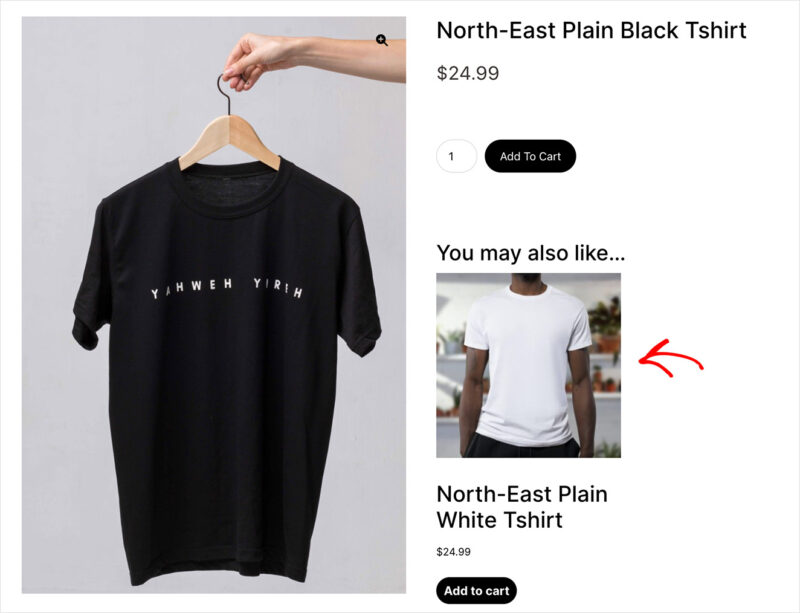
You can even create order bumps — small add-ons shown right on the checkout page — to boost conversions even more.
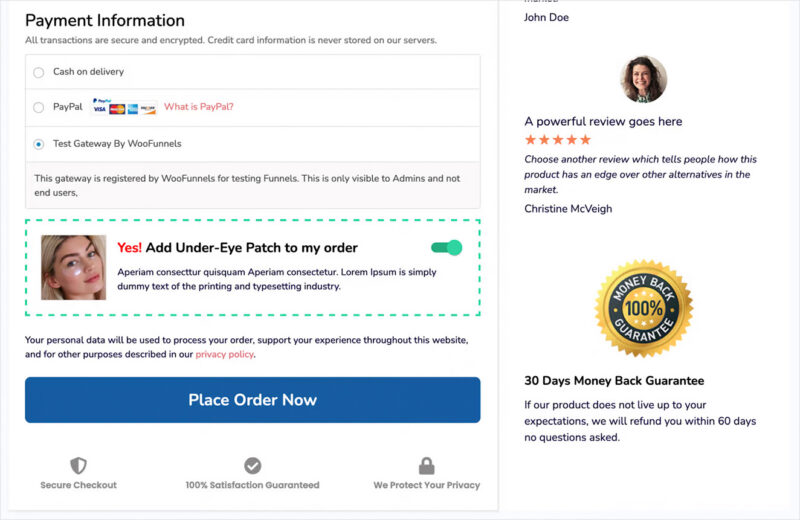
Combined with tools like SeedProd for page design, an upsell and checkout tool like FunnelKit gives you full control over the buyer’s journey from product to payment.
What is an upsell in a funnel?
An upsell is an extra offer shown during checkout. It encourages customers to buy more or upgrade.
What makes a good upsell offer?
Offer something that matches the first purchase. Examples: a warranty extension, premium version, or bundle deal.
5. Make a User-Friendly Checkout Page
A confusing checkout can kill a sale fast. Research shows that 18% of shoppers abandon their cart because the process feels too long or complicated. The goal is to make checkout quick, clear, and friction-free.
Based on my tests, SeedProd is one of the simplest ways to build a one-page checkout that actually converts. Its WooCommerce integration lets you create a clean layout with fewer form fields, which directly addresses the complexity issue and reduces cart abandonment.
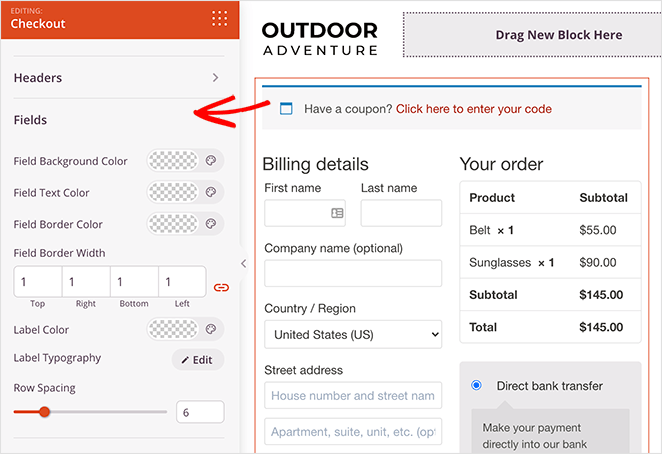
I’ve found that by using SeedProd’s checkout templates and removing unnecessary steps, I can help clients see smoother transactions and fewer drop-offs. The visual builder also lets me adjust spacing, add product grids, or include trust badges — all in minutes.
When your checkout is simple and distraction-free, you make it easier for visitors to finish what they started. That’s what turns browsing into buying.
Why does checkout design matter?
A slow or confusing checkout is the #1 reason people abandon carts. A simple, fast flow keeps buyers from dropping off.
What should a good checkout page include?
Clear pricing, product summary, multiple payment options, and an easy path to complete the order. Offer guest checkout so users don’t have to create an account.
6. Build a Thank You Page in WordPress
A thank you page is a strategic part of your funnel that confirms a purchase and guides your new customer’s next step. It’s your chance to build trust and even drive another sale.
An effective thank you page should include a genuine message, order details, and a clear call-to-action, like suggesting a related product or offering a special discount.
SeedProd has several high-quality templates you can use for your thank you page. The ‘eCommerce thank you page,’ is an excellent choice for its recommended products section.
You can also build a custom thank you page from scratch. Here’s an example I created:
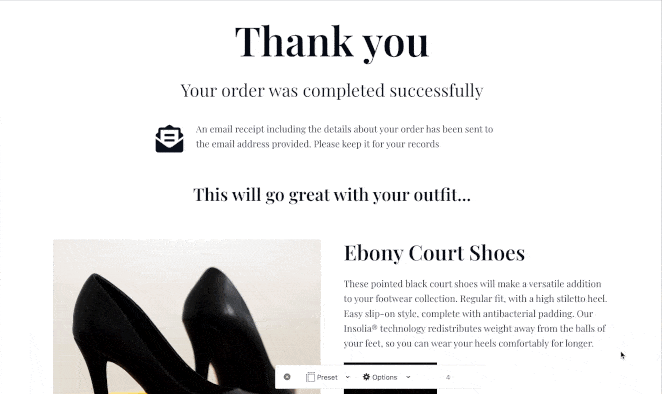
I included the following elements on my page:
- Thank you message telling users to check their email for a confirmation
- Cross-sell suggesting an additional product
- Countdown timer for sale products that are ending soon
- Popular products that other shoppers are buying
You can follow this guide on how to make a custom WooCommerce thank you page to make one just like it.
What should I include on a thank you page?
A genuine thank you message, order details, and next steps (like “check your inbox for confirmation”). You can also add product recommendations or a coupon for future orders.
What’s a smart way to use this page?
Cross-sell or upsell related products, invite customers to join your email list, or share helpful resources to keep them engaged.
7. Track Your Sales Funnel Results
You can’t improve what you don’t track. Monitoring your sales funnel helps you see where visitors drop off and where your sales come from, so you can focus your effort where it matters most.
I rely on MonsterInsights because it simplifies Google Analytics into clear, actionable reports right inside WordPress. Instead of sifting through complex dashboards, I can spot funnel drop-offs or top-performing pages in seconds.
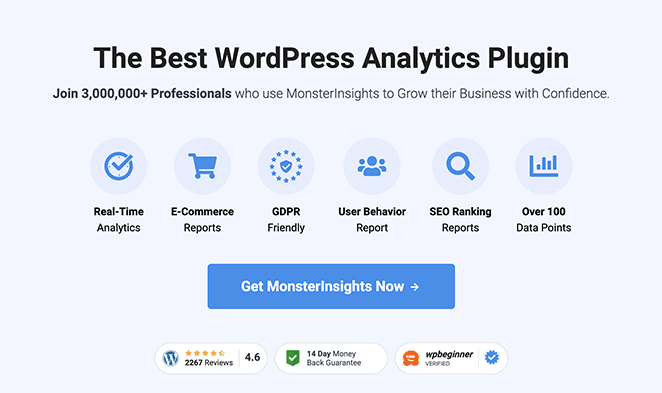
MonsterInsights helps me answer critical questions like, ‘Which page is causing visitors to leave?’ or ‘Where in the checkout process am I losing sales?’ On one site, it helped me identify that 30% of visitors were leaving before checkout — a discovery that led to quick design tweaks and an instant lift in completed purchases.
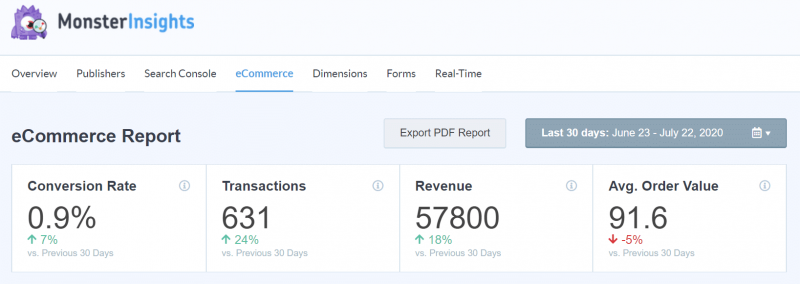
MonsterInsights saves me time and gives me data I can act on. That’s why it’s my go-to tool for keeping funnels optimized without the overwhelm of full Google Analytics.
Best Plugins to Build a WordPress Sales Funnel
To make a sales funnel in WordPress without hiring a developer, you’ll need the right tools. These are the plugins I’ve used myself. They’re beginner-friendly and work together without slowing down your site.
You don’t need all of these at once! You can start with a page builder and a form plugin, then add more tools as your business grows.
| Tool | Best For |
| SeedProd | Visually building all funnel pages (landing, thank you, checkout) with a drag-and-drop editor |
| WPForms | Creating lead capture and contact forms that integrate with email marketing tools |
| OptinMonster | Designing exit-intent popups and personalized opt-ins to recover abandoning visitors |
| MonsterInsights | Tracking funnel conversions, drop-offs, and eCommerce performance directly inside WordPress |
| FunnelKit | Building automated WooCommerce checkout funnels with one-click upsells and order bumps |
Each tool serves a unique purpose, but together they create a complete WordPress funnel system. I’ve used this exact combination to design and track high-converting funnels for both clients and personal projects.
Types of Sales Funnels You Can Create in WordPress
In my experience as a marketer, a standard sales funnel is just the beginning. I’ve built dozens of different funnel types for WordPress sites, and each one serves a specific goal depending on your audience and offer. Here are some of the most effective examples you can create using simple WordPress tools.
Lead Generation Funnel
| Goal: Collect email addresses and grow your list |
| Best Tools: SeedProd, WPForms, OptinMonster |
| Standout Features: 🔹 Free offer (ebook, checklist) 🔹 Simple signup form 🔹 Automated email follow-ups |
| Best For: Bloggers, small businesses, online coaches |
A lead generation funnel is made to collect contact details, like email addresses, from visitors. It usually starts with a lead generation landing page offering something valuable for free, like an eBook, a checklist, or access to a webinar.
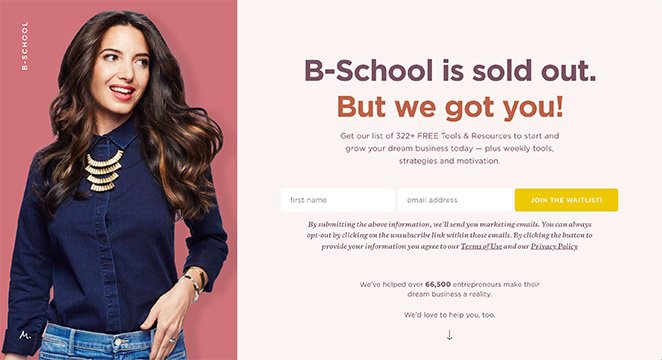
To get this free resource, visitors fill out a form with their email. Plugins like SeedProd or OptinMonster can help you create these forms and connect them to email tools like Mailchimp.
This type of funnel is great for bloggers and businesses who want to grow their audience and build relationships with potential customers.
Membership Funnel
| Goal: Sell recurring memberships or gated content |
| Best Tools: SeedProd, MemberPress, Restrict Content Pro |
| Standout Features: 🔹 Membership landing page 🔹 Secure login and payments 🔹 Automated onboarding emails |
| Best For: Online courses, communities, subscription businesses |
A membership funnel encourages people to pay for access to exclusive content or features. It starts with a membership landing page where users can sign up for a membership.
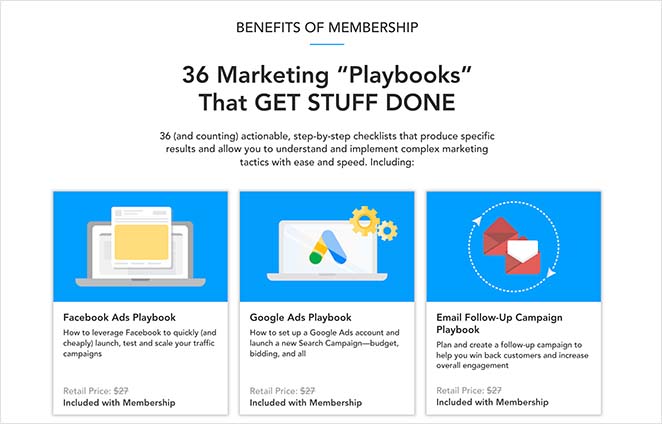
Tools like MemberPress or Restrict Content Pro can help you create a membership site and manage payments. After someone joins, you can send them emails to welcome them and explain how to get the most out of their membership.
Membership funnels work well for online communities, learning websites, or subscription-based businesses.
Webinar Funnel
| Goal: Fill seats for live or recorded webinars |
| Best Tools: SeedProd, Zoom, WebinarPress |
| Standout Features: 🔹 Webinar registration page 🔹 Countdown timers 🔹 Email reminders and replay link |
| Best For: Coaches, consultants, B2B marketers |
A webinar funnel helps you get people to sign up for and attend an online event. It starts with a webinar landing page where users can register for the webinar.
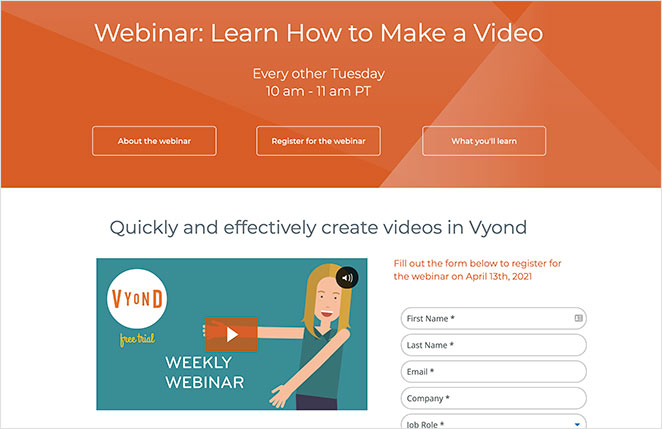
Adding a countdown timer can make the event feel more urgent and encourage people to sign up. After they register, send reminder emails to keep them excited.
You can use tools like Zoom or WebinarPress to host the webinar. After the event, follow up with an email to share a replay or an offer.
This type of funnel is great for coaches, consultants, and anyone using webinars to connect with their audience.
Free Trial or Product Demo Funnel
| Goal: Let users try before they buy |
| Best Tools: SeedProd, WPForms, WooCommerce Subscriptions |
| Standout Features: 🔹 Free trial landing page 🔹 Limited trial period 🔹 Upgrade emails after trial ends |
| Best For: SaaS companies, app developers, digital tools |
A free trial funnel is designed to let people try your product or service for free. It starts with a free trial landing page explaining what they’ll get and why it’s valuable.
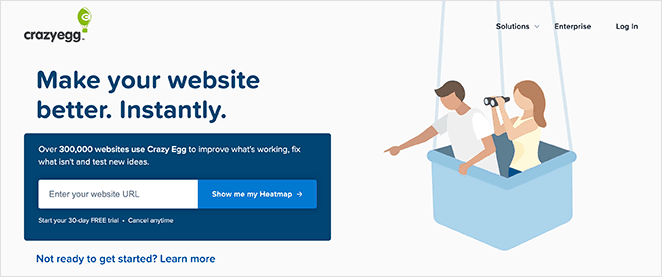
Visitors sign up by filling out a form. After the trial period ends, you can send emails encouraging them to become paying customers.
This funnel is a great fit for software companies or apps that want to show people the value of their product before they commit.
Event Funnel
| Goal: Promote and sell event registrations |
| Best Tools: SeedProd, Event Espresso, The Events Calendar |
| Standout Features: 🔹 Event landing page 🔹 Ticket sales and registration 🔹 Email reminders |
| Best For: Conferences, workshops, local events |
An event funnel is used to promote events like workshops or conferences. It begins with an event landing page where visitors can register and buy tickets.
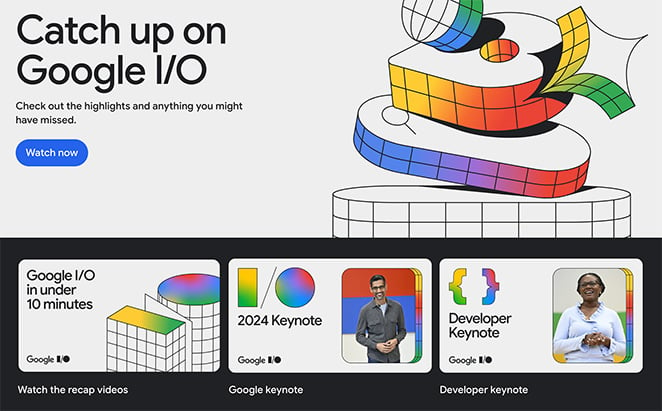
Plugins like Event Espresso or The Events Calendar make it easy to handle sign-ups and ticket sales. You can send reminder emails to make sure people attend.
This funnel works well for any event where you want to attract participants and manage their registrations.
FAQs About Making a Sales Funnel in WordPress
Start Building a High Converting Sales Funnel
I hope this guide has helped you learn how to set up a funnel in WordPress that drives leads, conversions, and sales.
You might also find our other guides helpful for growing your business:
- Landing Page vs Sales Page: Which One Is Right for You?
- Top eCommerce Landing Page Examples to Drive Sales
- How to Create a Coupon Code Landing Page to Drive More Sales
- Best CRM Software to Boost Business Sales
Thanks for reading! We’d love to hear your thoughts, so please feel free to join the conversation on YouTube, X and Facebook for more helpful advice and content to grow your business.

